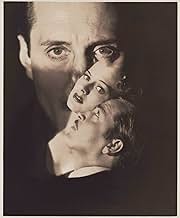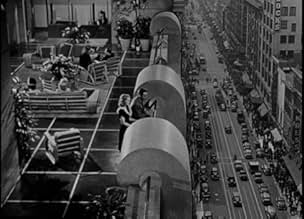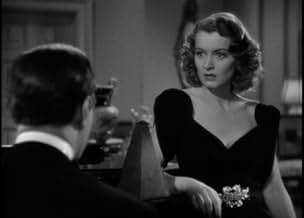CALIFICACIÓN DE IMDb
6.6/10
375
TU CALIFICACIÓN
Un médico loco se casa con una mujer adinerada y, con la ayuda de su demente asistente, la asesina por su dinero.Un médico loco se casa con una mujer adinerada y, con la ayuda de su demente asistente, la asesina por su dinero.Un médico loco se casa con una mujer adinerada y, con la ayuda de su demente asistente, la asesina por su dinero.
- Dirección
- Guionista
- Elenco
Barbara Jo Allen
- Louise Watkins
- (as Barbara Allen [Vera Vague])
Bobby Barber
- Bald Man in Library
- (sin créditos)
William 'Billy' Benedict
- Mickey Barnes - Copy Boy
- (sin créditos)
George Chandler
- Elevator Operator
- (sin créditos)
Edward Earle
- Librarian
- (sin créditos)
Chuck Hamilton
- Police Officer at Train Station
- (sin créditos)
Sam Harris
- Passerby
- (sin créditos)
Harry Hayden
- Ticket Clerk
- (sin créditos)
Douglas Kennedy
- Hotel Clerk
- (sin créditos)
Settar Körmükçü
- Dr. David Profesor
- (sin créditos)
John Laing
- Intern
- (sin créditos)
- Dirección
- Guionista
- Todo el elenco y el equipo
- Producción, taquilla y más en IMDbPro
Opiniones destacadas
"Oh, there's no such thing as sanity. At it's best a heroic and precarious little hiding place in which we try to conceal ourselves from the devils...The devils of time, space, things unknown, and the past."
Although its title suggests conventional horror, "The Mad Doctor" is a pitch black thriller with some with some truly harrowing subject matter. Basil Rathbone plays Dr. Sebastien, a Bluebeard-like psychiatrist who recently killed off his wealthy wife Ida. After arousing the suspicion of local doctor Ralph Morgan, Rathbone leaves town. He soon finds his next mark, a deeply troubled young socialite named Linda that's been suffering with suicidal ideations.
Rathbone is accompanied in his efforts by Martin Kosleck as Maurice, a sort of male secretary. After seeing these two interact, it becomes very clear that they are more than criminal accomplices. When we see Kosleck in Rathbone's home or office, he's variously arranging flowers, spritzing himself with cologne, fussing with Rathbone over a choice of tie, and languorously sketching a black cat while wearing a bathrobe. When Rathbone starts to become genuinely interested in Linda, Kosleck responds with wounded jealousy.
This is very obviously a coded gay relationship, years ahead of the one in Hitchcock's "Rope." The scenes between Rathbone and Kosleck, both superb actors, positively crackle. In one scene, Rathbone gives a bone chilling monologue describing his contempt for dead wife Ida: "These atrocious paintings. This absurd wallpaper. These pathetic antiques. They all breathe her spirit. I can almost see her now coming down those stairs with that foolish smile and the love light in her eyes. I can never forgive her the eight months spent in this cave of romance."
The danger and intensity only ratchet up from there, climaxing in a truly haunting and beautifully executed ending. This is one of Basil Rathbone's most underrated films.
Although its title suggests conventional horror, "The Mad Doctor" is a pitch black thriller with some with some truly harrowing subject matter. Basil Rathbone plays Dr. Sebastien, a Bluebeard-like psychiatrist who recently killed off his wealthy wife Ida. After arousing the suspicion of local doctor Ralph Morgan, Rathbone leaves town. He soon finds his next mark, a deeply troubled young socialite named Linda that's been suffering with suicidal ideations.
Rathbone is accompanied in his efforts by Martin Kosleck as Maurice, a sort of male secretary. After seeing these two interact, it becomes very clear that they are more than criminal accomplices. When we see Kosleck in Rathbone's home or office, he's variously arranging flowers, spritzing himself with cologne, fussing with Rathbone over a choice of tie, and languorously sketching a black cat while wearing a bathrobe. When Rathbone starts to become genuinely interested in Linda, Kosleck responds with wounded jealousy.
This is very obviously a coded gay relationship, years ahead of the one in Hitchcock's "Rope." The scenes between Rathbone and Kosleck, both superb actors, positively crackle. In one scene, Rathbone gives a bone chilling monologue describing his contempt for dead wife Ida: "These atrocious paintings. This absurd wallpaper. These pathetic antiques. They all breathe her spirit. I can almost see her now coming down those stairs with that foolish smile and the love light in her eyes. I can never forgive her the eight months spent in this cave of romance."
The danger and intensity only ratchet up from there, climaxing in a truly haunting and beautifully executed ending. This is one of Basil Rathbone's most underrated films.
1940's "The Mad Doctor" is a sadly generic but wholly appropriate title for this Paramount feature, one of their rare genre efforts (working titles "The Monster" and "A Date with Destiny"). In the title role of Dr. George Sebastian, Basil Rathbone is not a 'mad doctor' as in 'mad scientist,' but a psychotic faux psychiatrist living with partner Maurice Gretz (Martin Kosleck), both wanted for murder in Vienna, having relocated to America. With the sudden demise of Sebastian's third wife, he takes up residence in New York City, where he begins another practice, meeting up with potential wife number four, hypochondriac Linda Boothe (Ellen Drew), whom Maurice believes would be the perfect candidate due to her suicidal tendencies (that would save them the trouble of bumping her off). Lurking in the background is Dr. Charles Downer (Ralph Morgan), a longtime friend of Sebastian's late wife, whose suspicions about her untimely death are soon confirmed, at his peril. This Ben Hecht story is loaded with promise, yet fudges its attempts at suspense with sketchy characterizations, virtually none of whom engender any sympathy, particularly the heroine, apparently as dim as the scatterbrained sister (Barbara Allen) that introduced her to Dr. Sebastian. The binding relationship between the doctor and Maurice is by far the most intriguing aspect to the film, but little footage is devoted to their villainy, the pace slowed to a crawl by endless romantic twaddle. The final third almost makes up for all these faults, but the excellent cast is left pretty much on their own. Ellen Drew was much better, and far more sympathetic, in another Paramount, "The Monster and the Girl," while Martin Kosleck easily steals his scenes from the rather surprisingly uninspired Rathbone (much better in "Kind Lady"), soon to enjoy one of his finest villains opposite Tyrone Power in "The Mark of Zorro."
I remember seeing THE MAD DOCTOR on TV back in the early 1960s and although I didn't see it again until the release of this Blu-Ray half a century later, parts of it, especially the ending, had remained with me. Why this film has not made its bow on home video until now is beyond me. It's an A Movie, as can be seen by the big budget, but with B Movie sensibilities regarding its use of character players outside of Rathbone and its overall Film Noir look which is due to cinematographer Ted Tetzlaff. Even the title sounds like a B Movie. However the strongest element in the whole mix is the screenplay. More about that later.
The plot concerns a suave Svengali-like psychiatrist played by Rathbone who marries wealthy women and then disposes of them. He meets a wealthy socialite who has suicidal tendencies (Ellen Drew) and plans to make her his next victim. Can her reporter boyfriend (John Howard), whom she has rejected, save her in time? Nothing out of the ordinary there. What IS different in THE MAD DOCTOR is the relationship between Rathbone and his constant companion played by Martin Kosleck. It is clearly a gay relationship in everything but name and how it got past the 1940 censors is a question worth asking.
The screenplay was originally written by top writers Ben Hecht & Charles MacArthur in the early 1930s and intended for John Barrymore (hence the Svengali angle). It was originally called "The Monster" and later "Destiny". That explains the quality dialogue which is one of the movie's highlights. When Barrymore bowed out, the script sat on the shelf for 5 years before Paramount used it. They had changes made by Howard W. Green who received sole screen credit. Although full of dark moments, there is a lightness of touch from director Tim Whelan which adds to the enjoyment. Kino deserves credit for resurrecting this forgotten gem. Once you see it, you'll wonder why it stayed hidden for so long...For more reviews visit The Capsule Critic.
The plot concerns a suave Svengali-like psychiatrist played by Rathbone who marries wealthy women and then disposes of them. He meets a wealthy socialite who has suicidal tendencies (Ellen Drew) and plans to make her his next victim. Can her reporter boyfriend (John Howard), whom she has rejected, save her in time? Nothing out of the ordinary there. What IS different in THE MAD DOCTOR is the relationship between Rathbone and his constant companion played by Martin Kosleck. It is clearly a gay relationship in everything but name and how it got past the 1940 censors is a question worth asking.
The screenplay was originally written by top writers Ben Hecht & Charles MacArthur in the early 1930s and intended for John Barrymore (hence the Svengali angle). It was originally called "The Monster" and later "Destiny". That explains the quality dialogue which is one of the movie's highlights. When Barrymore bowed out, the script sat on the shelf for 5 years before Paramount used it. They had changes made by Howard W. Green who received sole screen credit. Although full of dark moments, there is a lightness of touch from director Tim Whelan which adds to the enjoyment. Kino deserves credit for resurrecting this forgotten gem. Once you see it, you'll wonder why it stayed hidden for so long...For more reviews visit The Capsule Critic.
This Unusual Film "Forecasts" an Anticipation of a Sub-Genre of Film-Noir. The Mental-Health Field...
It was Perhaps, the Dark Genre Most Go-To Subject-Matter with Psychiatry and the Many Unknowns and Rife with Controversy.
To Diagnosis Apart from the Usual Scientific Method that Resulted in "Evidence" from the Material-World.
The Methods Used in the Dual Practices of "Health-Care" were Mostly Diametrically Opposed in the Historical-Record. But with Sigmund Freud and His Peers Bringing the Field into Close Proximity "Hard-Science".
Treating Suffering Patients Needs, by Qualified Practitioners, Should be Taken Seriously. Not Dismissed and Ridiculed.
In 1940, the "Mad" in the Title Makes the Movie Sound Like a "Horror Movie". But, This Film Never Stray from its Roots of "Thriller",
It Explores Very-Dark, Complex Behavior.
Basil Rathbone Creating Charm, a Suave Demeanor, with a Confident Delivery of His "Svengali-Like" Power,
Dreamy-Eyed Ellen Drew is Overwhelmed by a Childhood Death or Her Father, by Suicide with Ensuing Nightmares.
She is Fine as a Victim of Trauma, and Handles the Complexity with an Essential Performance.
Another Reason this Forgotten Film is Required Viewing...
A Quirky Element that was Extremely Rare and Almost Non-Existent in "The Code" Years. An In-Your-Face Gay Couple. The Movie Doesn't Try and Hide it, although it Never Verbally Reveals it, but it's On-Screen with a Multitude of Stereo-Typical Behavior by Rathbone and His Companion.
It's On-Screen for Every-One from the Trailer-Park to the Penthouse to Understand. It's there, No Subtlety.
"The Mad Doctor" is a Hidden-Gem...
Wildly Unknown, and a Treat for Film-Fans that Love Discovering and Appreciating Movies that have a Certain Anti-Routine Approach and Takes Chances...
Willing to Create Outside Conventional Attitudes and Expectations in the World of "The Most Popular Art-Form of the 20th Century".
It was Perhaps, the Dark Genre Most Go-To Subject-Matter with Psychiatry and the Many Unknowns and Rife with Controversy.
To Diagnosis Apart from the Usual Scientific Method that Resulted in "Evidence" from the Material-World.
The Methods Used in the Dual Practices of "Health-Care" were Mostly Diametrically Opposed in the Historical-Record. But with Sigmund Freud and His Peers Bringing the Field into Close Proximity "Hard-Science".
Treating Suffering Patients Needs, by Qualified Practitioners, Should be Taken Seriously. Not Dismissed and Ridiculed.
In 1940, the "Mad" in the Title Makes the Movie Sound Like a "Horror Movie". But, This Film Never Stray from its Roots of "Thriller",
It Explores Very-Dark, Complex Behavior.
Basil Rathbone Creating Charm, a Suave Demeanor, with a Confident Delivery of His "Svengali-Like" Power,
Dreamy-Eyed Ellen Drew is Overwhelmed by a Childhood Death or Her Father, by Suicide with Ensuing Nightmares.
She is Fine as a Victim of Trauma, and Handles the Complexity with an Essential Performance.
Another Reason this Forgotten Film is Required Viewing...
A Quirky Element that was Extremely Rare and Almost Non-Existent in "The Code" Years. An In-Your-Face Gay Couple. The Movie Doesn't Try and Hide it, although it Never Verbally Reveals it, but it's On-Screen with a Multitude of Stereo-Typical Behavior by Rathbone and His Companion.
It's On-Screen for Every-One from the Trailer-Park to the Penthouse to Understand. It's there, No Subtlety.
"The Mad Doctor" is a Hidden-Gem...
Wildly Unknown, and a Treat for Film-Fans that Love Discovering and Appreciating Movies that have a Certain Anti-Routine Approach and Takes Chances...
Willing to Create Outside Conventional Attitudes and Expectations in the World of "The Most Popular Art-Form of the 20th Century".
Doctor Ralph Morgan calls at Basil Rathbone's home. His patient, Rathbone's wife, has died. Morgan is suspicious; she was recovering. He does nothing about it.
His suspicions are justified. Rathbone speaks with his manservant, Martin Kosleck, of how much he despised his rich wife and her stupid town, just like his other victims. They will return to New York, and he to his practice as a psychiatrist. There he is hired to deal with Ellen Drew, a depressed and suicidal socialite whose newspaper boyfriend, John Howard, has his suspicions. His investigations lead him to Morgan, even as Miss Drew marries Rathbone.
Rathbone offers his usual graceful performance as a man struggling with redemption. Most noteworthy of all, however, is Ellen Drew's performance as someone suicidal when we first meet her, to someone lighthearted after the ordinary pleasures of Coney Island. Alas, there is no sign of revival of her psychoses at the end, but in that era, endings had to be happy, even in a movie that focuses on Rathbone's attempts to deal with his own dark desires.
Hecht and MacArthur did uncredited work on the script, and they undoubtedly gave the producers what they asked for; neither was director Tim Whelan the man to stand up for a darker vision; he had returned to the US doing work on Korda's THE THIEF OF BAGDAD, and this was his first movie after that. It was no time to antagonize the brass at Paramount.
His suspicions are justified. Rathbone speaks with his manservant, Martin Kosleck, of how much he despised his rich wife and her stupid town, just like his other victims. They will return to New York, and he to his practice as a psychiatrist. There he is hired to deal with Ellen Drew, a depressed and suicidal socialite whose newspaper boyfriend, John Howard, has his suspicions. His investigations lead him to Morgan, even as Miss Drew marries Rathbone.
Rathbone offers his usual graceful performance as a man struggling with redemption. Most noteworthy of all, however, is Ellen Drew's performance as someone suicidal when we first meet her, to someone lighthearted after the ordinary pleasures of Coney Island. Alas, there is no sign of revival of her psychoses at the end, but in that era, endings had to be happy, even in a movie that focuses on Rathbone's attempts to deal with his own dark desires.
Hecht and MacArthur did uncredited work on the script, and they undoubtedly gave the producers what they asked for; neither was director Tim Whelan the man to stand up for a darker vision; he had returned to the US doing work on Korda's THE THIEF OF BAGDAD, and this was his first movie after that. It was no time to antagonize the brass at Paramount.
¿Sabías que…?
- TriviaOne of over 700 Paramount Productions, filmed between 1929 and 1949, which were sold to MCA/Universal in 1958 for television distribution, and have been owned and controlled by Universal ever since; its earliest documented telecast took place in Seattle Monday 11 May 1959 on KIRO (Channel 7).
- ErroresAt the Library, Sebastien shades over a page with a pencil to see the impression of what was written there earlier but when he tears the page off the pad, the page is untouched.
- Citas
Maurice Gretz: You're like all the other clever ones, clever until they meet a woman, and then they suddenly become fools.
- ConexionesReferenced in Svengoolie: Night Monster (2015)
- Bandas sonorasAloha 'Oe
Music by Queen Liliuokalani
Selecciones populares
Inicia sesión para calificar y agrega a la lista de videos para obtener recomendaciones personalizadas
- How long is The Mad Doctor?Con tecnología de Alexa
Detalles
- Fecha de lanzamiento
- País de origen
- Idioma
- También se conoce como
- The Mad Doctor
- Locaciones de filmación
- Productora
- Ver más créditos de la compañía en IMDbPro
- Tiempo de ejecución1 hora 30 minutos
- Color
- Relación de aspecto
- 1.37 : 1
Contribuir a esta página
Sugiere una edición o agrega el contenido que falta

Principales brechas de datos
By what name was La cita fatal (1940) officially released in India in English?
Responda


































